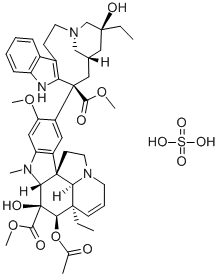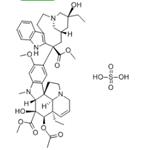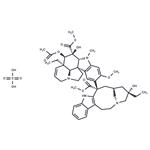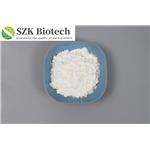Vinblastine sulfate is the salt of an alkaloid extracted from Vinca rosea Linn., a common flowering herb known as the periwinkle (more properly known as Catharanthus roseus G. Don). Previously, the generic name was vincaleukoblastine, abbreviated VLB. It is a stathmokinetic oncolytic agent. When treated in vitro with this preparation, growing cells are arrested in metaphase. Chemical and physical evidence indicate that vinblastine sulfate is a dimeric alkaloid containing both indole and dihydroindole moieties.
Vinblastine sulfate is a white to off-white crystalline powder that is freely soluble in water, soluble in methane, and slightly soluble in ethanol. Its empiric formula is C46H58N4O9.H2SO4 , and it has a molecular weight of 909.07.
Vinblastin sulfate USP (Velban) is used to treat Hodgkin’s disease; lymphosarcoma; reticulum cell sarcoma; neuroblastoma; choriocarcinoma; carcinoma of breast, lung, oral cavity, testis, bladder; acute and chronic leukemia; histiocytosis; mycosis fungoides.
Anticancer agent; microtubule disrupter; Induces apoptosis.Vinblastine sulfate is therapeutically used as an antineoplastic. It is also used in the treatment of Hodgkin disease, choriocarcinoma, acute and chronic leukemias.
ChEBI: Vincaleukoblastine sulfate is an alkaloid sulfate salt. It is functionally related to a vincaleukoblastine.
Vinblastine Sulfate is the sulfate salt of vinblastine, a natural alkaloid isolated from the plant Catharanthus roseus (Madagascar periwinkle) with antineoplastic properties. Vinblastine disrupts microtubule formation and function during mitosis and interferes with glutamic acid metabolism. (NCI04)
Water soluble..Rapidly hydrolyzes.
Vinblastine sulfate is sensitive to light, hydrolysis, oxidation, and heat. Vinblastine sulfate is very hygroscopic. .
SYMPTOMS: Symptoms of exposure to Vinblastine sulfate include temporary mental depression, paresthesias, loss of deep-tendon reflexes, headache, convulsions, psychoses; dysfunction of the autonomic nervous system, with marked constipation, paralytic ileus, urinary retention, bilateral pain and tenderness of the parotid glands associated with dryness of the mouth, sinus tachycardia; nausea, vomiting, anorexia, diarrhea; loss of hair, vesicular mucositis of the mouth, and dermatitis.
Anticancer agent; microtubule disrupter. Induces apoptosis in cultured hepatocytes and human lymphoma cells.
Primary TargetInteraction of tubulin with microtubule-associated proteins, specifically Tau and MAP2
Vinblastine sulfate is available as a powder in 10-mg vials and as a solution in 10- and 25-mL vials for IV administrationin the treatment of various cancers including Hodgkin’sdisease, lymphocytic lymphoma, histiocytic lymphoma, advancedmycosis fungoides, advanced testicular carcinoma,and Kaposi sarcoma. It has also been used in treating choriocarcinomaand breast cancer when other therapies havefailed.
The major toxic effect of vinblastine is a dose-related bone marrow depression. This is more frequent and severe than with the close structural analog, vincristine. Dose-related leukopenia occurs with a nadir of 4 to 10 days and with recovery occurring over another 7 to 14 days. Because of the relatively predictable nadir, it may be possible to administer vinblastine cautiously as often as every 7 to 10 days. Thrombocytopenia typically occurs; however, with standard dosing regimens, serious platelet depressions are infrequent. Erythrocytes are usually only slightly depressed.
Poison by ingestion,
intraperitoneal, and intravenous routes. An
experimental teratogen. Human systemic
effects by intravenous route: blood
leukopenia and hair changes. Experimental
reproductive effects. Questionable
carcinogen. Human mutation data reported. When heated to decomposition it emits very
toxic fumes of NOx and SOx. See also
VINCALEUKOBLASTINE and
SULFATES.
Veterinary Drugs and Treatments
Vinblastine may be employed in the treatment of lymphomas, carcinomas,
mastocytomas, and splenic tumors in small animals. It is
more effective than vincristine in the treatment of canine mast cell
tumors.
Potentially hazardous interactions with other drugs
Aldesleukin: avoid concomitant use.
Antibacterials: toxicity increased by erythromycin
- avoid; possible increased risk of ventricular
arrhythmias with delamanid.
Antiepileptics: phenytoin levels may be reduced.
Antifungals: possible increased risk of toxicity with
itraconazole; metabolism possibly inhibited by
posaconazole (increased risk of neurotoxicity).
Antimalarials: avoid with piperaquine with
artenimol.
Antipsychotics: avoid with clozapine (increased risk
of agranulocytosis).
Vinblastine is extensively metabolised mainly in
the liver by the CYP3A group of isoenzymes to
desacetylvinblastine, which is more active than the parent
compound. 33
% of the drug is slowly excreted in the urine
and 21
% in the faeces within 72 hours.
Crystallise the sulfate from MeOH or EtOH and dry it in vacuo over conc H2SO4. The free base crystallises from EtOH or MeOH m 211-216o (+ 2MeOH .1 H2O) and forms a stable etherate from Et2O with m 201-211o, and [] D +42o (CHCl3), and UV max at 214 and 259nm (log � 4.73 and 4.21). The dihydrochloride has m 244-246o(dec)(MeOH). It is a monoamine oxidase B inhibitor and induces microtubule aggregation. It is an antineoplastic drug for Hodgkin’s lymphoma. [Neuss et al. J Am Chem Soc 81 4754 1959, Jong-KeunSon et al. J Med Chem 33 1845 1990, Warfield & Bouck Science 186 1219 1974, Beilstein 26 III/IV 3167.]
Vinblastine binds to tubulin and inhibits microtubule assembly. This inhibition prevents mitotic spindle formation and results in an accumulation of cells in metaphase.
Vinblastine is considered cell cycle phase speci�c for mitosis; however, the cytotoxic effect probably occurs in S phase and is expressed only in M phase. At high doses, direct effects may be expressed in S and G1 phases. Vinblastine is assumed to have stathmokinetic (cell cycle arrest) effects similar to vincristine.



